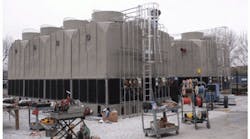At Indiana State University's (ISU's) 190-acre main campus in Terre Haute, Ind., renovation of a building that would become the College of Education was nearing completion.
"Because the capacity at the central chilled-water plant had become nearly exhausted, we decided to install a stand-alone chiller and also allow the building to be connected to the chilled-water plant," Mark J. Pupilli, ISU building and facilities manager, said. "So, of course, we were going to need a cooling tower."
At the suggestion of Indianapolis-based supplier AC Equipment Representatives Inc., ISU looked at plastic cooling towers from Delta Cooling Towers Inc.
Cooling towers with shells made of engineered plastics—high-density polyethylene (HDPE) in particular—require much less maintenance and are more energy-efficient than cooling towers with galvanized-steel-sheeted shells and often virtually eliminate costly downtime.
The Delta line offered many features Pupilli liked. He was impressed with the selection of available models, the product quality, and the 15-year warranty on the double-walled HDPE shells.
Pupilli decided to purchase a 550-ton Delta Premier Series tower for the College of Education building. The Premier Series features an induced-draft, counterflow design and a low-pressure-drop, self-propelled polyvinyl-chloride water-distribution system. It also features a direct-drive fan powered by a totally enclosed, energy-saving variable-frequency-drive (VFD) motor. Modular construction allows clustering for greater cooling tonnage.
Like other Delta designs, the Premier model is relatively light in weight, impervious to ultraviolet rays, and virtually corrosion-proof.
Recently, ISU received funding to build a satellite chilled-water plant for redundancy, as well as much-needed additional capacity in the central chilled-water system.
"When we were working on the design of the satellite chilled-water plant, we realized that we wanted to utilize Delta cooling towers at that location as well," Pupilli said. "And so I have two four-cell TM Series towers with a cooling capacity of 2,500 tons at the new satellite chilled-water plant. And each of the towers is connected to a VFD."
The TM Series is a selection of induced-draft, counterflow-design cooling towers available in single-unit capacities from 250 to 2,000 cooling tons.
The configuration at the satellite plant is two banks of four TM towers that are operated as eight separate towers.
"We also have the space to expand the facility in the future," Pupilli said. "For example, we could put in another 2,500-ton chiller in there at a later date and also add two more banks of eight cooling towers."
Pupilli said the towers are "working painlessly."
"We did have a minor fan-motor problem, but the treatment we got from Delta has left a very positive impression because they took care of the matter so quickly," Pupilli said. "But we have never had any problems with the cooling towers."
Pupilli said a primary reason for choosing the engineered-plastic technology was to avoid the repeated coatings associated with metal cooling towers.
Information and photograph courtesy of Delta Cooling Towers Inc.
For Design Solutions author guidelines, call Scott Arnold, executive editor, at 216-931-9980, or write to him at [email protected].









